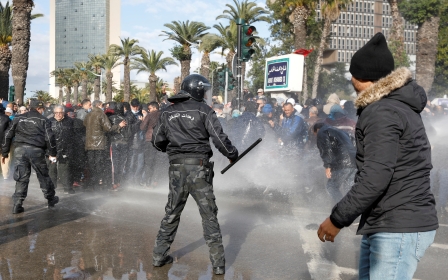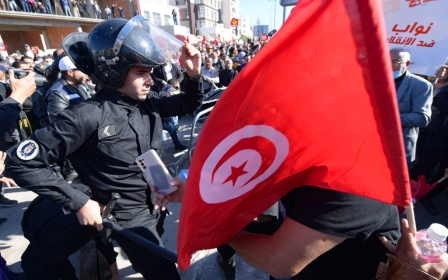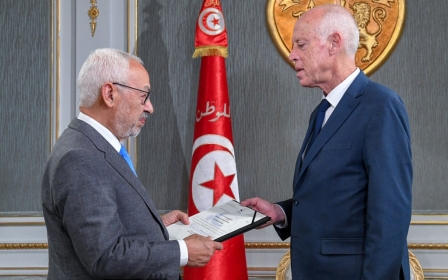Tunisia: How disbanding judicial council marks the culmination of Saied's power grab
By dissolving Tunisia’s Supreme Judicial Council (CSM), President Kais Saied has effectively taken full control of the judicial, legislative and executive powers in the country, according to analysts.
Saied said on Sunday the CSM will be dissolved in an upcoming decree, accusing the body, seen as the “last line of defence to his one-man rule”, of bias and corruption.
His move was widely condemned by judges and opposition leaders. Head of the CSM Youssef Bouzakher called it illegal, and vowed the "judges will not be silent" and will continue to carry out their duties.
Middle East Eye takes a look at why the dissolution of the CSM represents a major turning point in the ongoing political crisis and what it means for Tunisia’s democratic future.
What is the Supreme Judicial Council?
New MEE newsletter: Jerusalem Dispatch
Sign up to get the latest insights and analysis on Israel-Palestine, alongside Turkey Unpacked and other MEE newsletters
The CSM is an independent constitutional body that aims to uphold the independence of the judiciary in the country.
It was revamped after the 2011 revolution, which toppled the 23-year autocratic rule of late Tunisian President Zine el-Abidine Ben Ali.
As part of the post-revolution 2014 constitution, the CSM was reshaped to effectively remove any influence of the executive branch, namely the Ministry of Justice and the presidency, who both practically controlled the body in the past.
'[CSM] was the result of painstaking years of hard work amongst Tunisia's elected representatives, both in the constituent assembly and in parliament after the 2011 revolution'
- Monica Marks, lecturer, NYU Abu Dhabi
It was eventually set up in 2016 after independent members were elected to the body.
The 45 members are tasked with ensuring the independence of judges. They oversee their appointment, promotion and disciplinary proceedings.
The body also represents the judiciary in dealing with the executive and the legislative branches.
One of the most important powers of the body is the selection of four of the 12 judges that would sit in the Constitutional Court, a body equivalent to a supreme court.
The other eight members were to be picked by the parliament and the president, each nominating four judges.
The Constitutional Court was never established in Tunisia due to years of political disagreement over candidates in parliament.
Yet, the CSM was still considered one of Tunisia's “key post-revolutionary achievements on the road toward the democratic institution building,” Monica Marks, professor and Tunisia analyst, told MEE.
“It was the result of painstaking years of hard work amongst Tunisia's elected representatives, both in the constituent assembly and in parliament after the 2011 revolution,” the lecturer at New York University Abu Dhabi said.
“It was set up to try to correct Tunisia's long, sordid history of dictatorial control over the judiciary.”
Why did Saied disband the CSM?
The decision to dissolve the CSM came seven months after Saied suspended parliament, dismissed the prime minister, assumed vast executive powers and said he could rule by decree.
He invoked Article 80 of the constitution as the legal justification for his power grab measures, seen by opposition groups as a coup, which was widely contested.
'What you have is basically the president making unilateral decisions that are unconstitutional and unlawful'
- Said Benarbia, MENA director, ICJ
He also declared himself the chief prosecutor, a move rejected by the CSM. Since then, the legal body has drawn the ire of Saied who repeated criticism of the judiciary, calling for its “purification” in October.
“What you have is basically the president making unilateral decisions that are unconstitutional and unlawful,” Said Benarbia, MENA director of the International Commission of Jurists (ICJ) told MEE.
It is unclear what legal basis Saied has relied on in disbanding the CSM as he is yet to release the decree that would officially dissolve it.
Benarbia said there is “no constitutional or legal basis whatsoever” for his move. But "because the military and the police are implementing his decisions, they have the effect of de facto force," he added.
On Monday, the headquarters of the CSM in Tunis was shut down by security forces, barring employees from accessing the building.
Bouzakher, the head of the council, said the body will carry on their work regardless, but with the executive branch under Saied’s grip, it might prove irrelevant in the end.
“They need a budget, financial means which are both voted by the parliament. Only the executive branch has the power to allocate funds and budget,” Benarbia said.
“The judiciary, with time, will be under the control and the subordination of the executive branch using financial means to pressure judicial institutions and cement the one-man rule that's been in place for the past seven months.”
What does this mean for Tunisia?
Saied vowed on Monday evening, hours after the CSM building was locked, that he does not want to interfere with the judiciary.
"I assure everyone in Tunisia and abroad that I will not interfere in the judiciary. I will not interfere in any case or any appointment. I do not want to control all power," Saied said in a speech.
But a number of judges' associations and critics have raised the alarm that Saied’s move could mark the end of any hope for democracy in Tunisia.
“The question today isn't if Tunisia is a dictatorship [or not], it's whether Saied can consolidate his dictatorship. And what happened on Sunday indicates that he is speeding in the direction of dictatorial consolidation,” Marks told MEE.
The Tunisia analyst believes that Saied’s unilateral moves have “capsized” the 2014 constitution and set Tunisia years back.
“If Saied disappeared tomorrow, putting this institution back together and re-stitching the fabric of Tunisia's democratic institutions, that he has been systematically shredding since 25 July, would take years,” she said.
The only way back would be for the opposition to come together and provide an alternative vision to Saied’s rule, Marks said, an unlikely scenario considering how “weak and fragmented” political parties have been since 25 July.
Another source of pressure on Saied is the international community, whose reaction to the dissolution of the CSM will be crucial for the country’s future, Benarbia believes.
“One of the important elements is the reaction of the international community and the pressure that institutions such as the European Union or individual states, France, the US and their ability to stand up for the rule of law in the country,” Benarbia said.
“It is a matter of utmost urgency right now for the international community to react with a unified voice and urge return to the constitutional order.”
On Tuesday, the ambassadors of Canada, France, Germany, Italy, Japan, the UK, the US and the EU issued a joint statement on Saied's move saying they are "deeply concerned".
"A transparent, independent and efficient judiciary and the separation of powers are essential for a functioning democracy that serves its people, on the basis of the rule of law and fundamental rights and freedoms," the statement read.
Middle East Eye delivers independent and unrivalled coverage and analysis of the Middle East, North Africa and beyond. To learn more about republishing this content and the associated fees, please fill out this form. More about MEE can be found here.






